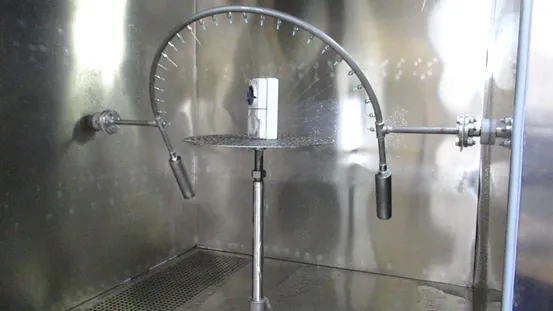MIL STD 810H Method 506 Rain and Water Ingress Testing
The MIL STD 810H Method 506 Rain and Water Ingress Testing is a critical protocol designed to evaluate the resistance of electronic devices, systems, and components to rain and water ingress. This testing ensures that equipment can operate reliably in harsh environmental conditions, such as those encountered during deployment or use in outdoor environments.
The primary objective of this testing method is to determine the ability of an item to withstand the effects of rainfall without compromising its functionality. Rainfall exposure is simulated using a combination of various parameters including intensity, duration, and angle of rain application. The test aims at verifying that the product can perform its intended function under these conditions.
Method 506 specifies several types of rain tests, each tailored to different scenarios. For instance, Type I tests are designed for low-pressure environments where light rainfall is expected, while Type II tests cater to moderate pressure and heavier precipitation. Understanding these nuances helps in selecting the most appropriate test type based on the anticipated environmental conditions.
The testing procedure involves placing a specimen under controlled rain conditions that mimic real-world scenarios as closely as possible. The duration of exposure can vary depending upon the specific requirements set forth by MIL-STD-810H, but it typically ranges from minutes to hours. During this period, the test equipment continuously monitors the specimen for signs of water ingress.
Once the exposure ends, thorough inspections are conducted to check for any damage or degradation in performance due to water exposure. This includes visual inspections as well as functional assessments to ensure that there has been no adverse impact on the device's integrity and operation.
The results of these tests play a crucial role in determining whether products meet military specifications and can be deployed in challenging environments with confidence. Compliance with MIL-STD-810H provides assurance not only regarding rain resistance but also other environmental factors like shock, vibration, temperature variations, etc., thereby enhancing overall product reliability.
For organizations involved in the design, manufacturing, or procurement of electronic devices intended for use in demanding environments, adhering to this standard ensures that their products are robust enough to withstand potential hazards. By incorporating MIL STD 810H Method 506 Rain and Water Ingress Testing into their quality control processes, businesses can enhance customer satisfaction by delivering reliable products that meet strict regulatory requirements.
Why It Matters
The importance of conducting MIL-STD 810H Method 506 Rain and Water Ingress Testing cannot be overstated. In industries like defense, aerospace, and maritime sectors where equipment must operate reliably even in extreme weather conditions, this testing method becomes indispensable.
- Ensures durability against environmental challenges.
- Safeguards against potential failures due to water exposure.
- Promotes compliance with international standards ensuring global acceptance.
In addition to enhancing product longevity and performance, successful completion of these tests significantly improves brand reputation among end-users. It demonstrates a commitment to excellence in manufacturing practices that ultimately leads to increased market competitiveness.
Moreover, by meeting the stringent criteria outlined by MIL-STD-810H, companies can secure contracts with government agencies or defense contractors who demand high levels of reliability from their suppliers. This not only opens up new business opportunities but also fosters long-term relationships built on trust and mutual respect.
Quality and Reliability Assurance
MIL-STD 810H Method 506 Rain and Water Ingress Testing plays a pivotal role in maintaining the highest standards of quality assurance within an organization. Here are some key aspects that contribute to ensuring reliable outcomes:
- Consistent Test Conditions: Maintaining precise control over environmental factors such as temperature, humidity, and rainfall intensity ensures consistent results across multiple trials.
- Thorough Inspections: Post-test examinations provide detailed insights into any potential issues caused by water exposure, allowing for prompt corrective actions if necessary.
- Data Analysis: Careful analysis of collected data helps identify trends and patterns that could indicate areas needing improvement in design or production processes.
By integrating these practices into regular testing protocols, manufacturers can continuously improve the robustness of their products, reducing instances of failure under adverse conditions. This proactive approach ultimately contributes to building a stronger foundation for long-term success in highly competitive markets.
Use Cases and Application Examples
| Application Example | Description |
|---|---|
| Aircraft Avionics | Critical components within aircraft avionics systems must withstand heavy rainfalls during takeoffs and landings. |
| Marine Electronics | Electronic devices used in maritime applications should be able to function effectively despite prolonged exposure to saltwater environments. |
| Medical Devices | In medical settings, electronic equipment needs to maintain its integrity even when exposed to moisture during use or storage. |
| Telecommunications Equipment | Outdoor telecommunication devices must be resistant to water ingress to ensure uninterrupted service delivery. |
Each of these examples highlights the diverse range of applications where MIL-STD 810H Method 506 Rain and Water Ingress Testing is essential. By adhering to this standard, manufacturers can cater specifically to the unique requirements faced by various industries while ensuring that their products perform consistently across all expected conditions.





